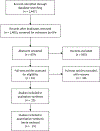Outcomes After Tracheostomy in Patients with Severe Acute Brain Injury: A Systematic Review and Meta-Analysis
- PMID: 33033959
- PMCID: PMC8363498
- DOI: 10.1007/s12028-020-01109-9
Outcomes After Tracheostomy in Patients with Severe Acute Brain Injury: A Systematic Review and Meta-Analysis
Abstract
Objective: To synthesize reported long-term outcomes in patients undergoing tracheostomy after severe acute brain injury (SABI).
Methods: We systematically searched PubMed, EMBASE, and Cochrane Library for studies in English, German, and Spanish between 1990 and 2019, reporting outcomes in patients with SABI who underwent tracheostomy. We adhered to the preferred reporting items for systematic reviews and meta-analyses guidelines and the meta-analyses of observational studies in epidemiology guidelines. We excluded studies reporting on less than 10 patients, mixed populations with other neurological diseases, or studies assessing highly select subgroups defined by age or procedures. Data were extracted independently by two investigators. Results were pooled using random effects modeling. The primary outcome was long-term functional outcome (mRS or GOS) at 6-12 months. Secondary outcomes included hospital and long-term mortality, decannulation rates, and discharge home rates.
Results: Of 1405 studies identified, 61 underwent full manuscript review and 19 studies comprising 35,362 patients from 10 countries were included in the meta-analysis. The primary outcome was available from five studies with 451 patients. At 6-12 months, about one-third of patients (30%; 95% confidence interval [CI] 17-48) achieved independence, and about one-third survived in a dependent state (36%, 95% CI 28-46%). The pooled short-term mortality for 19,048 patients was 12%, (95% CI 9-17%) with no significant difference between stroke (10%) and TBI patients (13%), and the pooled long-term mortality was 21% (95% CI 11-36). Decannulation occurred in 79% (95% CI 51-93%) of survivors. Heterogeneity was high for most outcome assessments (I2 > 75%).
Conclusions: Our findings suggest that about one in three patients with SABI who undergo tracheostomy may eventually achieve independence. Future research is needed to understand the reasons for the heterogeneity between studies and to identify those patients with promising outcomes as well as factors influencing outcome.
Keywords: Intracranial hemorrhage; Ischemic stroke; Severe acute brain injury; Subarachnoid hemorrhage; Tracheostomy; Traumatic brain injury.
Conflict of interest statement
The authors report no relevant financial disclosures or conflict of interest.
Figures







References
-
- Creutzfeldt CJ, Longstreth WT, Holloway RG. Predicting decline and survival in severe acute brain injury: the fourth trajectory. BMJ. 2015;351:h3904. - PubMed
-
- Quill TE, Holloway R. Time-limited trials near the end of life. JAMA. 2011;306(13):1483–4. - PubMed
-
- Kurtz P, Fitts V, Sumer Z, et al.How does care differ for neurological patients admitted to a neurocritical care unit versus a general ICU? Neurocritical care. 2011;15(3):477–80. - PubMed
-
- Damuth E, Mitchell JA, Bartock JL, et al.Long-term survival of critically ill patients treated with prolonged mechanical ventilation: a systematic review and meta-analysis. Lancet Respir Med. 2015;3(7):544–53. - PubMed
Publication types
MeSH terms
Grants and funding
LinkOut - more resources
Full Text Sources
Medical

